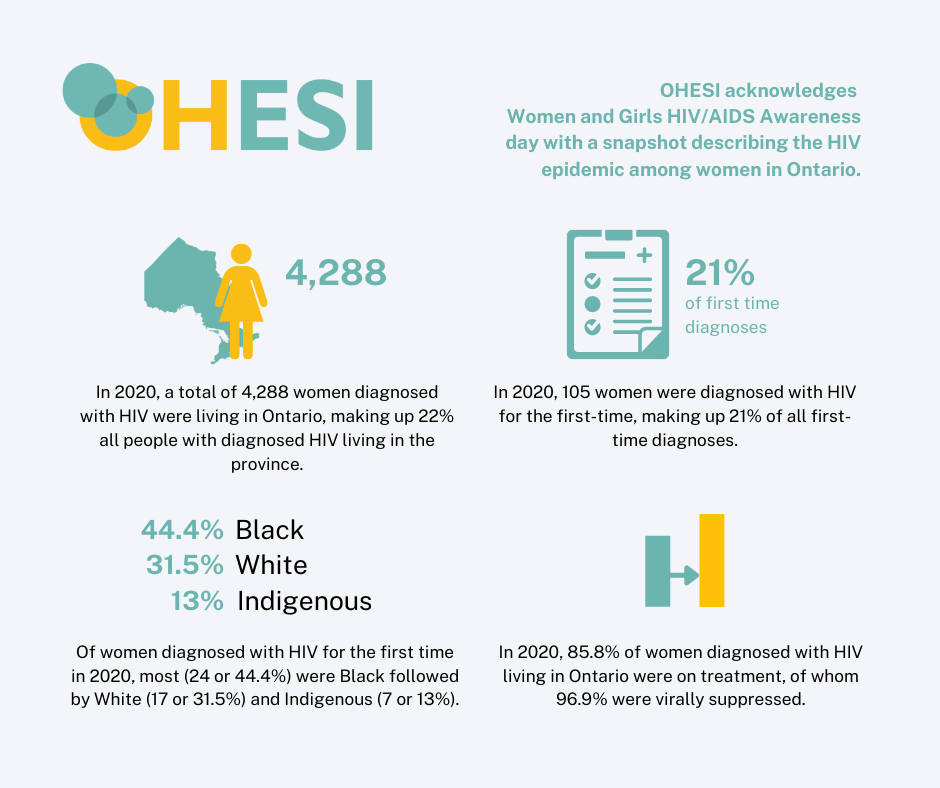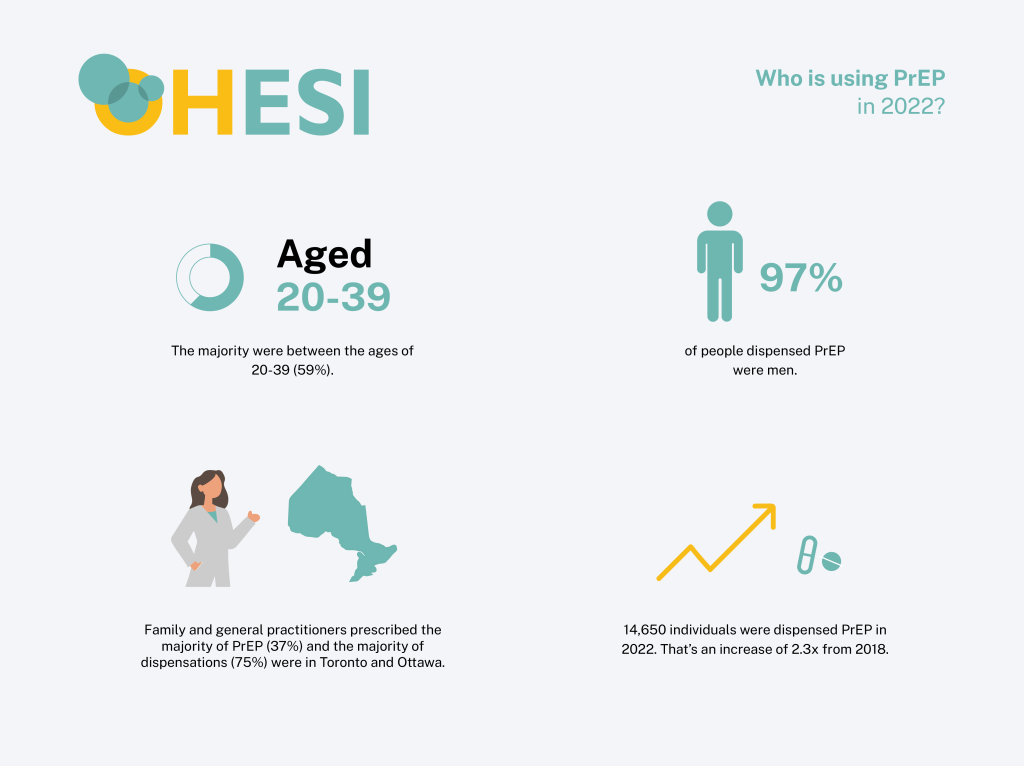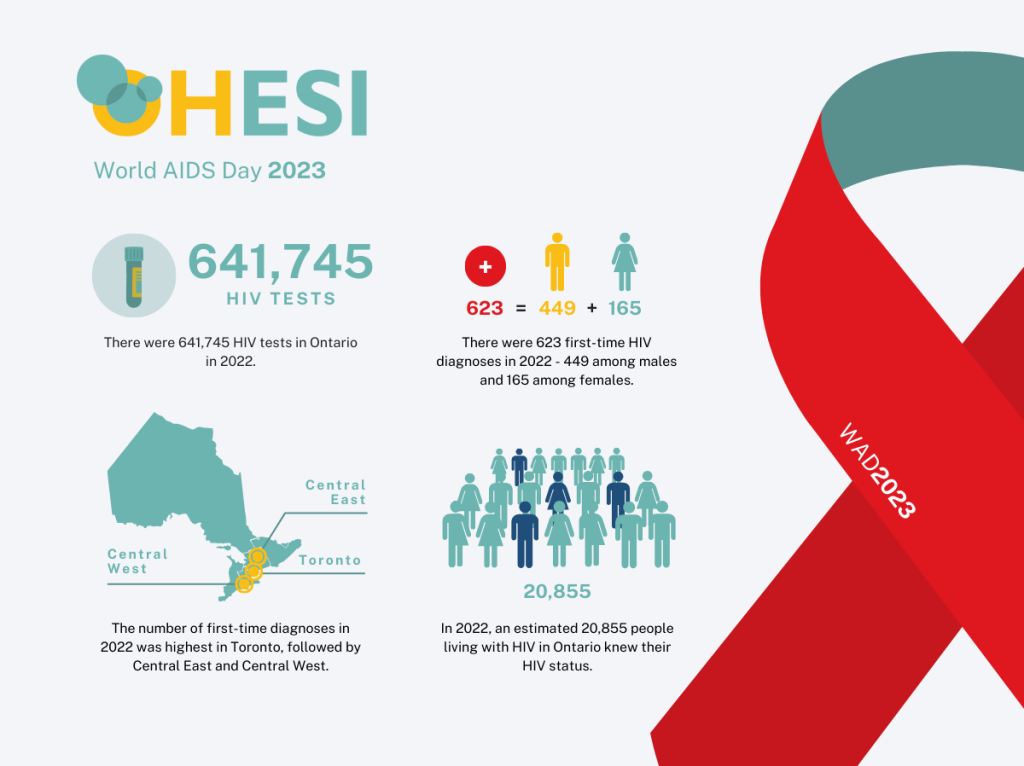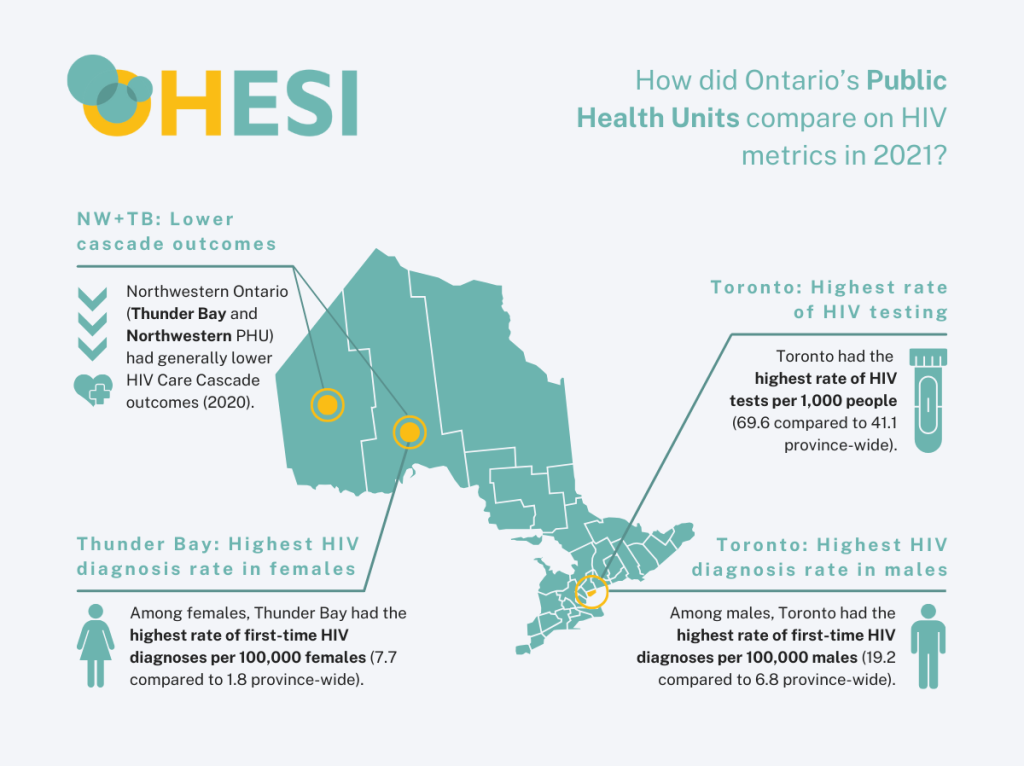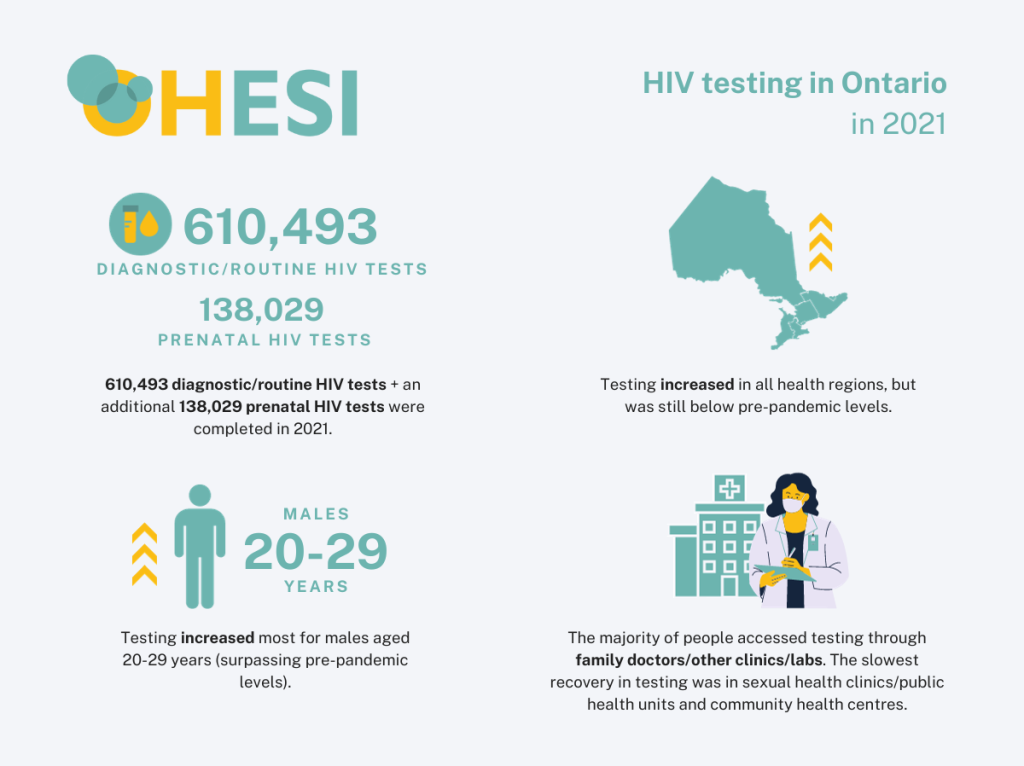Mar 9th, 2022
A Snapshot of HIV Diagnoses and the HIV Care Cascade among Women in Ontario
To commemorate Women and Girls HIVAIDS Awareness Day 2022, the Ontario HIV Epidemiology and Surveillance Initiative (OHESI) is pleased to provide a snapshot describing the HIV epidemic among women in Ontario. This blog post highlights 2020 data on HIV tests, diagnoses and the HIV care cascade among this population.
Women are a priority population for HIV programming in Ontario. Women who face a greater risk for HIV exposure include:
- Cisgender and Transgender/2 Spirit women who are a part of another Ontario HIV priority population:
- African, Caribbean and Black women
- Indigenous women
- Women who use injection drugs
- Trans and Non-Binary femme folks
- Other women who face systemic and social inequities, who are more likely to be exposed to HIV through a sexual or drug using partner
For more information about efforts to prevent HIV, improve outcomes for women living with HIV in Ontario and to learn about the ways to build capacity for those working in care and prevention, visit the Women HIV/AIDS Initiative.
Key messages
- In 2020, a total of 4,288 women diagnosed with HIV were living in Ontario, making up 22% all people with diagnosed HIV living in the province.
- Women receiving a positive HIV test in Ontario fall into two distinct groups:
- Women diagnosed for the first time in Ontario who are more likely to have acquired HIV in Ontario.
- Women living with HIV who have already been diagnosed elsewhere (i.e. have previous evidence of HIV) and likely acquired HIV outside of Ontario.
- It’s important to understand the nature of both these groups to:
- plan holistic care, treatment and other culturally informed services for those who already know their status as well as those who are newly diagnosed, and
- understand who is at risk of HIV and use that information to strengthen Ontario’s prevention and testing programs.
- Trends for 2020 should be interpreted with caution. Due to the COVID-19 pandemic, there was a decrease in HIV testing, which may have resulted in some missed diagnoses. There was also a significant decrease in immigration, which affected the number of positive tests in women who had been diagnosed elsewhere and were tested again when they moved to Ontario. For more information on how to interpret 2020 data, see our blog post on the Impact of COVID-19 Pandemic on HIV Testing and Diagnoses in Ontario.
Testing and Diagnosis
- HIV testing among women decreased in the province in 2020 by 23% (2019: 325,318 vs 2020 249,655); however, the number of pregnant people tested for HIV was essentially unchanged (2019: 138,038 vs 2020 138,299).
- Both first-time diagnoses and positive tests with previous evidence of HIV in women decreased in 2020. The decrease in migration during the COVID-19 pandemic led fewer women who already knew their HIV status to enter care in the province, while the decrease in testing may have meant that fewer first-time diagnoses were captured.
- At least 35% of the 142 women who received a positive HIV test in 2020 already knew their HIV status (had previous evidence of HIV) and were entering care in Ontario for the first time, while as many as 65% were first-time HIV diagnoses. It is important to note that when information on test history is missing, individuals are categorized as first-time HIV diagnoses by default. Therefore, these figures likely overstate the proportion classified as first-time HIV diagnoses. Using historic test history completion rates, OHESI estimates approximately 15% of women classified as first-time HIV diagnoses had already been diagnosed elsewhere and knew their HIV status.
- Looking specifically at first-time HIV diagnoses in 2020, approximately one in five were among women. This has is similar to the proportion of first-time diagnoses among women for the period between 2016 and 2020, which averaged 21%.
- Of the 105 women diagnosed with HIV for the first time in Ontario in 2020, 54 had race demographic data reported. Among these, most (24 or 44.4%) were Black, followed by White (17 or 31.5%) and Indigenous (7 or 13%).
- Most women diagnosed with HIV for the first time in 2020, for whom HIV exposure category was reported, (31 or 52.5%) reported they were exposed to HIV through heterosexual contact with an identified risk2
- Compared to 2019, the number of first-time HIV diagnoses among women in Ontario decreased for all regions in 2020; however decreases were larger in some regions (Toronto) than others (Northern).
HIV Care Cascade
- How are women diagnosed with HIV engaged in the HIV care cascade? As of 2020, there were 4,288 women diagnosed with HIV living in Ontario. Of those diagnosed, 3,812 (88.9%) were in care, 3,678 (85.8%) were on ART, and 3,565 (83.1%) were virally suppressed.
- Regarding the UNAIDS 90-90-90 targets (90% people living with HIV diagnosed; 90% of people with HIV on anti-retroviral treatment, and 90% on treatment virally suppressed), estimates have not been completed for the undiagnosed fraction in 2020 for women. For the last two measures: 85.8% of women diagnosed with HIV were on ART, of whom, 96.9% were virally suppressed.
- Comparing the two-year periods of 2014-2015 and 2018-19, the proportion of females diagnosed with HIV who linked to care within 3 months of diagnosis increased from 75.5% to 82.6%, and the proportion who achieved viral suppression within 6 months of diagnosis increased from 38.3% to 61.5%.
Trends in HIV among Women in Ontario
Trends in HIV testing among women
Testing rates have historically been high among women in Ontario, and have continued to increase over time. Due to the pandemic, there was a decrease in HIV testing in Ontario – the number of tests conducted (excluding prenatal) decreased by 23%.
The HIV prenatal testing program in Ontario is robust, with more than 97% of pregnant people having received an HIV test prior to birth. The number of pregnant people who received a prenatal HIV test in 2020 was 138,229, with essentially no change between 2019 and 2020.
Figure 1. Number of HIV tests (thousands), Women, Ontario, 2011-2020
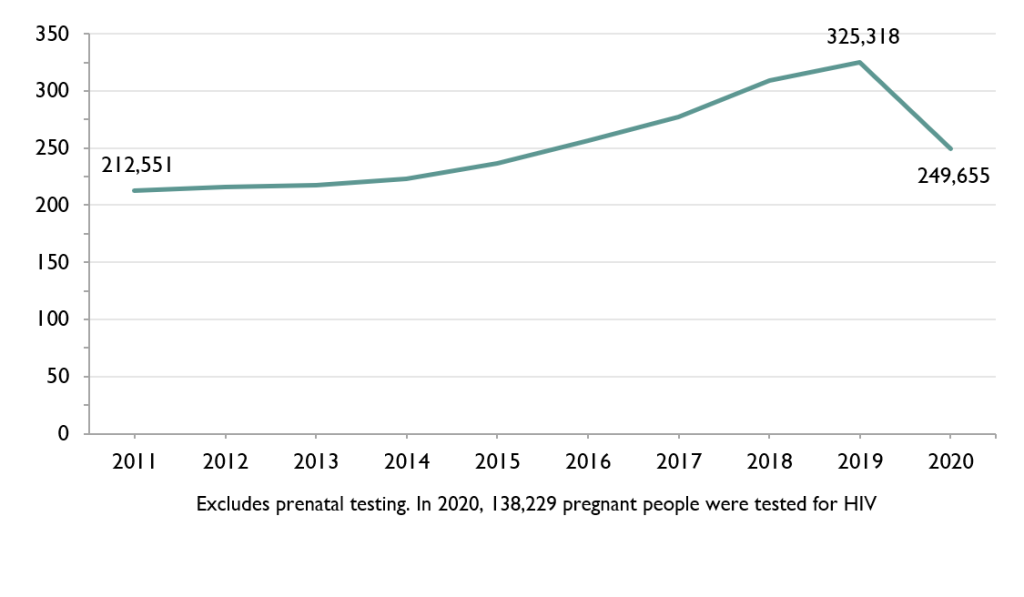
Trends in the number of women diagnosed with HIV
Decreases in testing likely impacted the number of women diagnosed for the first time in 2020. Additionally, decreases in immigration and migration in 2020 led to fewer positive tests with previous evidence of HIV.
Of the 142 total positive HIV tests among women in Ontario in 2020, at least 37 (35.2%) were women who already knew they had HIV – that is, women diagnosed elsewhere who were entering care in Ontario – and 105 (64.8%) were considered first-time HIV diagnoses, meaning they were more likely to have acquired HIV in Ontario. Using historic test history information, OHESI estimates that approximately 15% of women categorized as first-time HIV diagnoses between 2010 and 2019 already knew they had HIV before testing positive in Ontario.
The number of positive HIV tests among women who already knew their HIV status in 2019 was 2.6 times higher than in 2016; however, in 2020 this decreased back to what was seen earlier in the decade.
In 2020, women made up about one in five first-time HIV diagnoses (21%), and this proportion was fairly stable between 2016 and 2020, averaging 21%.
Figure 2. Number of first-time HIV diagnoses and people with previous evidence of HIV, Women, Ontario, 2011-2020
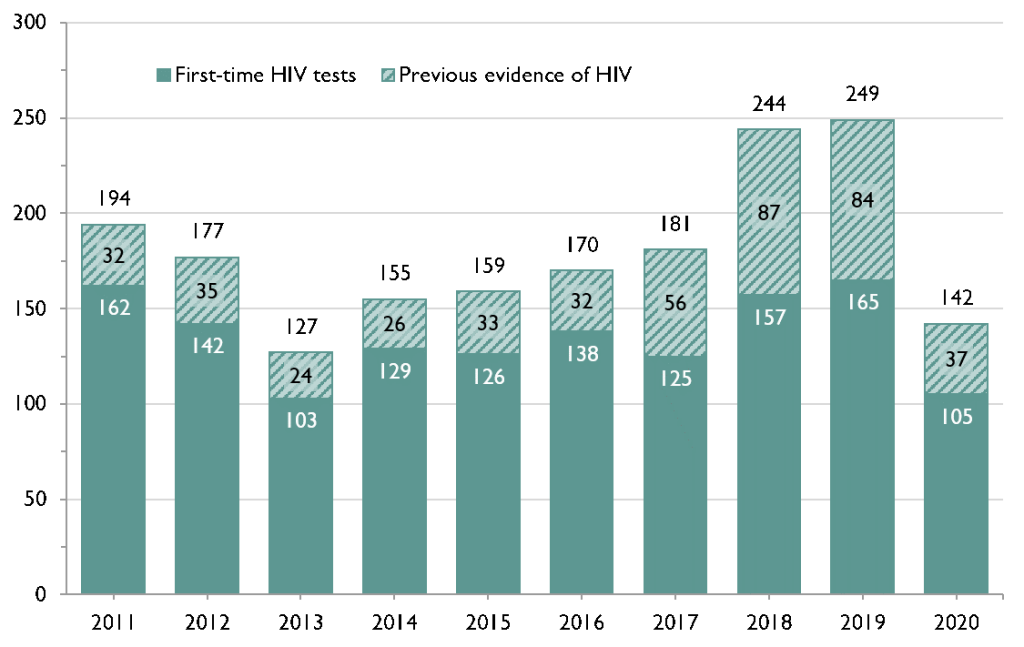
Majority of women diagnosed with HIV for the first time reported heterosexual contact with an identified risk
An HIV exposure category was reported in 59 of the 105 first-time diagnoses in 2020, of those, 31 (52.5%) reported heterosexual contact with an identified risk2, 15 (25.4%) reported injection drug use (IDU), and 13 (22.0%) reported heterosexual contact with no identified risk2. This pattern is very consistent with previous years: the COVID-19 pandemic did not seem to affect any category disproportionately.
Figure 3a. Number of first-time HIV diagnoses by HIV exposure category (where reported), Women, Ontario, 2016-2020
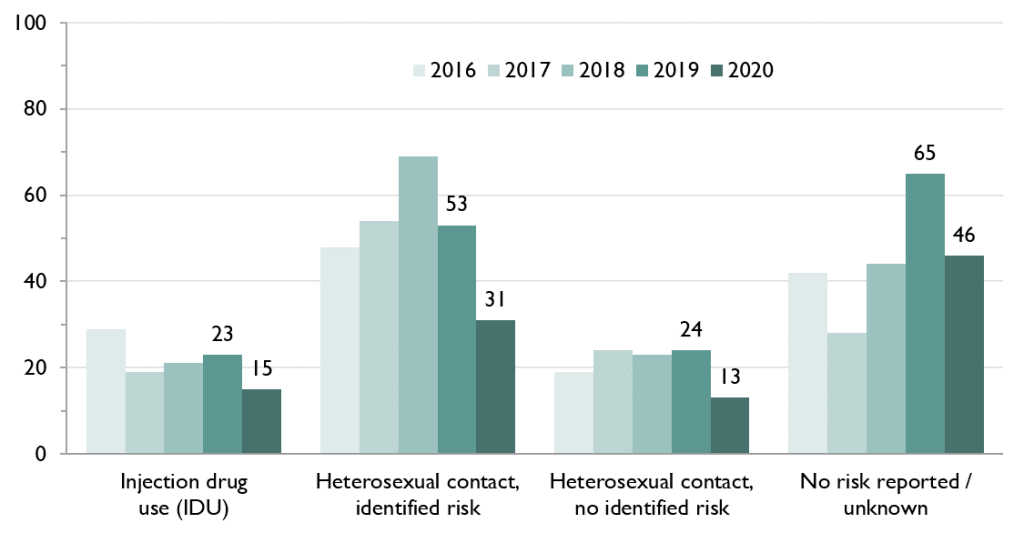
Figure 3b. Percent of first-time HIV diagnoses by HIV exposure category (where reported), Women, Ontario, 2016-2020
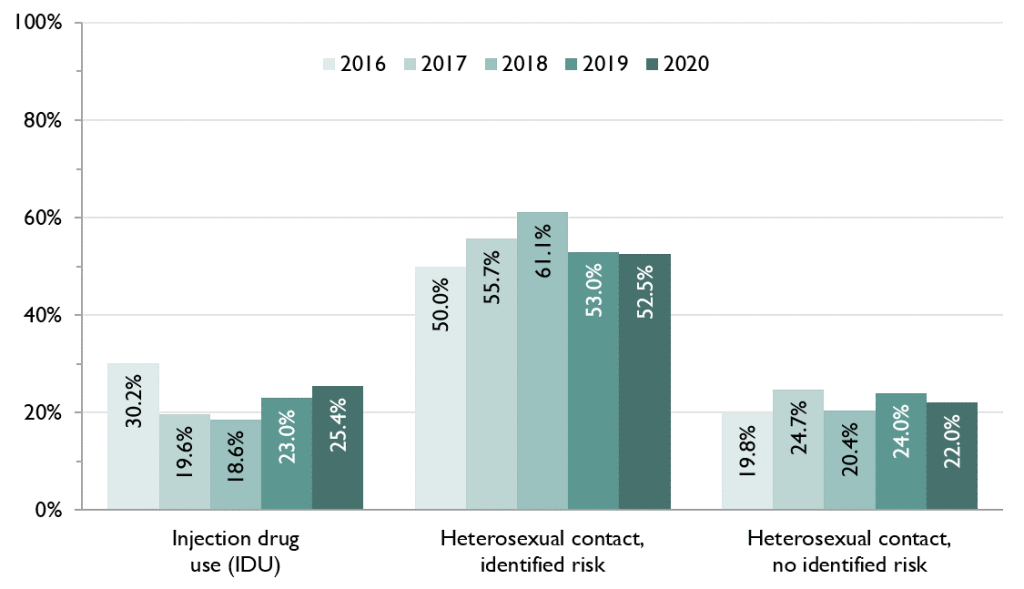
2“Identified risk” means either the individual’s country of birth is reported as an HIV-endemic country, or the individual’s opposite-sex/gender partner is reported to be at least one of: HIV-positive; user of injection drugs; born in an HIV-endemic country; a bisexual male.
Among women diagnosed with HIV for the first time the largest proportion were Black
Race/ethnicity was reported for 54 of the 105 first-time diagnoses in women in 2020. Of those, 24 (44.4%) were Black, 17 (31.5%) (17) were White, 13.0% (7) were Indigenous, and 11.1% (6) were women of other race/ethnicities. No race was reported for 51 women in 2020. These proportions are all within 5-year trends and, as counts are smaller for women, small variations by year may not indicate a trend.
Figure 4a. Number of first-time HIV diagnoses by race/ethnicity, Women, Ontario, 2016-2020
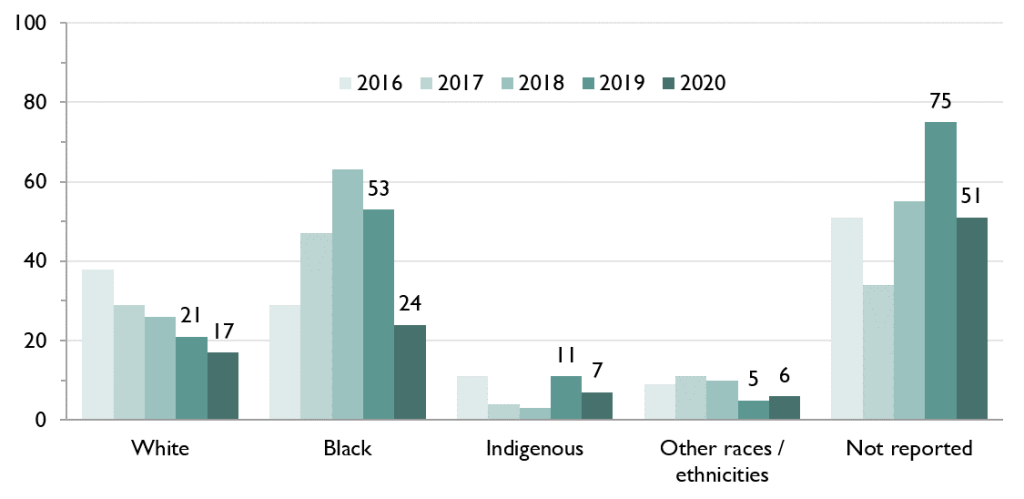
Figure 4b. Percent of first-time HIV diagnoses by race/ethnicity (where reported), Women, Ontario, 2016-2020
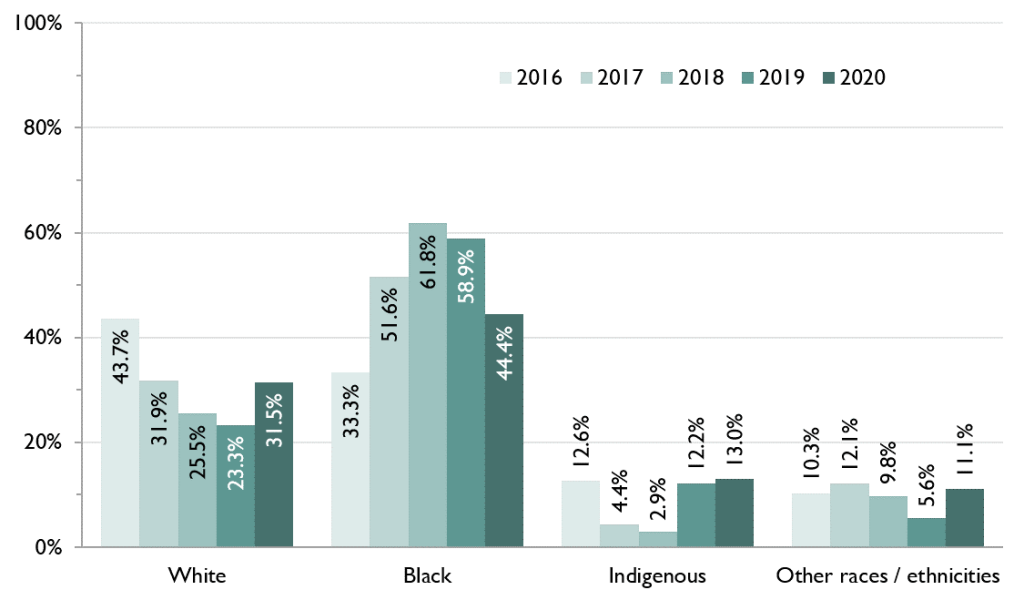
Number of women diagnosed with HIV for the first-time decreased in all regions
In 2020, the number of first-time HIV diagnoses among women decreased from 2019 in all regions. The Eastern (2), Toronto (40) and Central East (15) regions had the largest relative decreases, while the Ottawa (16) and Northern (14) regions had smaller relative declines. The lower numbers in 2020 may be due to a mix of factors, that may differ by region, including: a true decrease in HIV infections, less testing during the COVID-19 pandemic, and missing information on testing history in previous years that may have caused more women to be misclassified as a first-time diagnosis. Trends should be interpreted with caution and will be better understood as data is monitored over time and post pandemic.
Figure 5. Number of first-time HIV diagnoses by region, Women, Ontario, 2016-2020
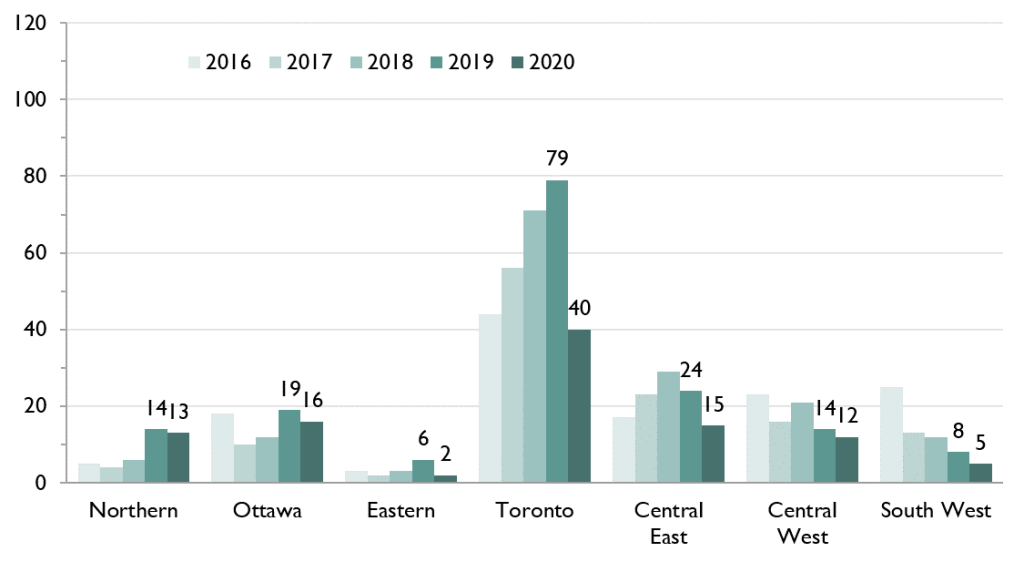
The HIV Care Cascade among Women
The HIV care cascade is a way to assess whether all Ontarians living with HIV are getting appropriate care and have the opportunity to achieve good health outcomes. That cascade monitors three key indicators: the proportion of people diagnosed with HIV who are in care, the proportion who are on antiretroviral treatment (ART), and the proportion who are virally suppressed (which protects their health and prevents HIV transmission to their sexual partners).
Over 4,000 women diagnosed with HIV were living in Ontario in 2020
As of 2020, there were a total of 4,288 women diagnosed with HIV living in Ontario. Of those diagnosed, 3,812 (88.9%) were in care, 3,678 (85.8%) were on ART, and 3,565 (83.1%) were virally suppressed. High levels of engagement in care and on treatment mean that most people living with HIV are virally suppressed and cannot pass on the virus to other people through sexual contact.
Figure 6. Number of women diagnosed with HIV, in care, on ART, and virally suppressed, Ontario, 2020
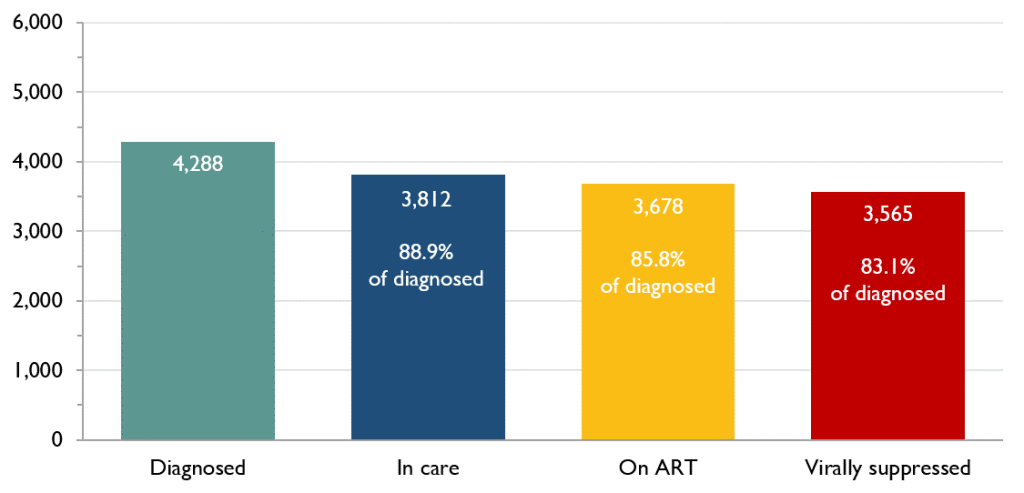
Most women living with diagnosed HIV in Ontario were in care, on ART and virally suppressed in 2020
The UNAIDS 90-90-90 targets are set globally to compare HIV prevention and treatment across jurisdictions. The set the target of 90% people living with HIV diagnosed; 90% of people with HIV on anti-retroviral treatment, and 90% on treatment virally suppressed. Estimates have not been completed for the undiagnosed fraction in 2020 for women. For the last two measures: 85.8% of women diagnosed with HIV were on ART, of whom 96.9% were virally suppressed (VL<200 copies/ml).
Figure 7. UNAIDS 90-90-90 Targets, Women, Ontario, 2020
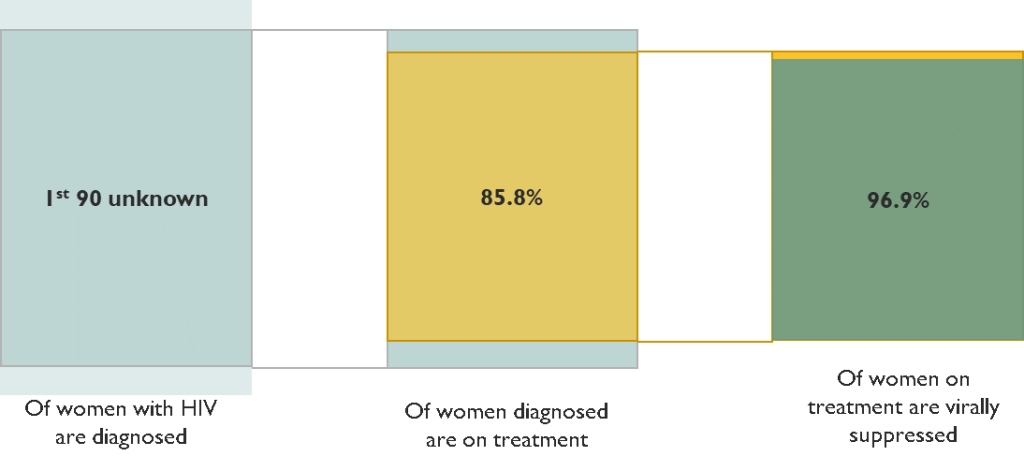
Women diagnosed with HIV are linking to care and becoming virally suppressed more quickly
Between the two-year periods 2014-2015 and 2018-2019, the proportion of women diagnosed with HIV who linked to care within 3 months of diagnosis increased from 75.5% to 82.6%.
Figure 8. Percent of women diagnosed with HIV who linked to care within 3 months of diagnosis, Ontario, 2014-2015 to 2018-2019
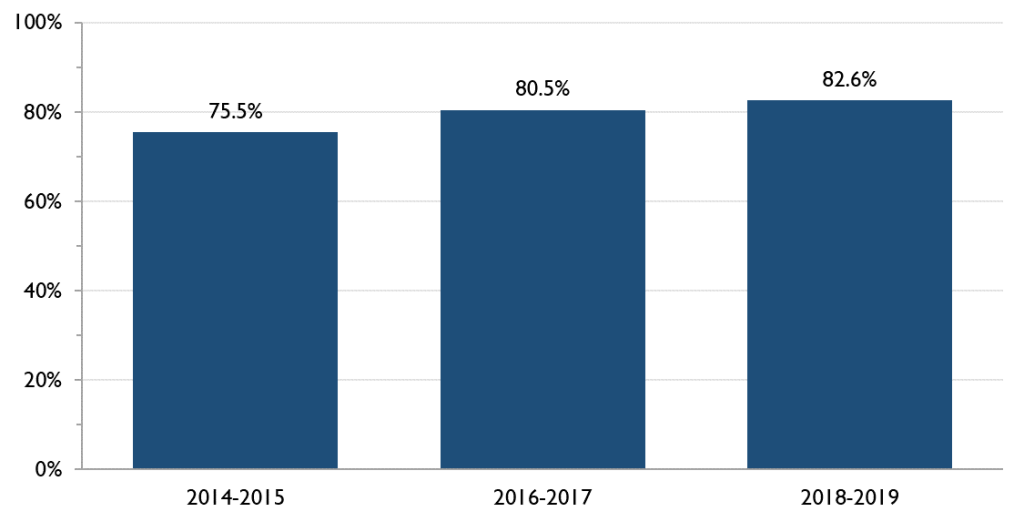
Between the two-year periods 2014-2015 and 2018-2019, the proportion of women diagnosed with HIV who achieved viral suppression within 6 months of diagnosis increased from 38.3% to 61.5%.
Figure 9. Percent of women diagnosed with HIV who achieved viral suppression within 6 months of diagnosis, Ontario, 2014-2015 to 2018-2019
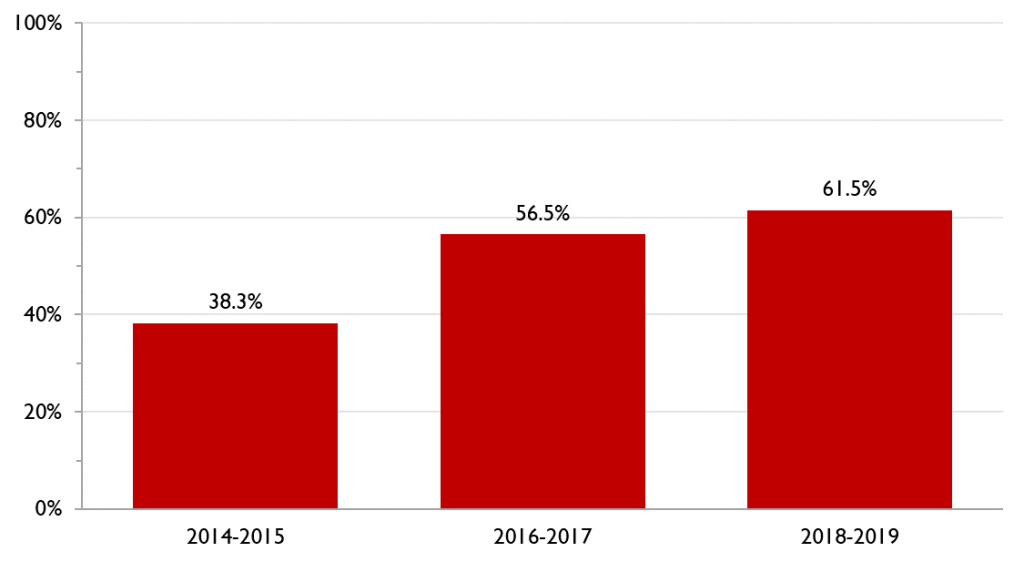
1Between 2011 and 2020, sex was not reported for less than 1% of first-time HIV diagnoses per year. Data shown are where sex was reported.
Find this information and more in our upcoming 2020 Testing in Diagnosis Reports!
OHESI is a collaboration involving AIDS and Hepatitis C Programs of the Ontario Ministry of Health, Public Health Ontario, the Public Health Agency of Canada, and the Ontario HIV Treatment Network. The objectives of OHESI are to analyze, monitor and disseminate knowledge products on the epidemiology of HIV in Ontario.

